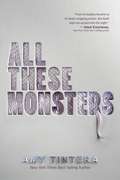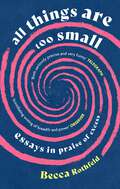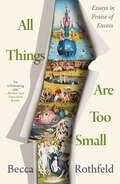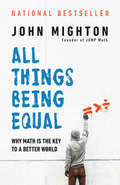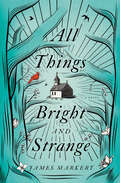- Table View
- List View
All These Monsters (All These Monsters)
by Amy TinteraFrom New York Times best-selling author Amy Tintera, a high-stakes sci-fi adventure about a teen girl who will do anything to escape her troubled home—even if that means joining a dangerous monster-fighting squad. Perfect for fans of Warcross and Renegades. Seventeen-year-old Clara is ready to fight back. Fight back against her abusive father, fight back against the only life she&’s ever known, and most of all, fight back against scrabs, the earth-dwelling monsters that are currently ravaging the world. So when an opportunity arises for Clara to join an international monster-fighting squad, she jumps at the chance. When Clara starts training with her teammates, however, she realizes what fighting monsters really means: sore muscles, exhaustion, and worst of all, death. Scrabs are unpredictable, violent, and terrifying. But as Clara gains confidence in her battle skills, she starts to realize scrabs might not be the biggest evil. The true monsters are the ones you least expect.
All These Perfect Strangers
by Aoife CliffordPraise for All These Perfect Strangers 'A stunning debut' Sydney Morning Herald 'Vivid and fresh' The Age 'Unputdownable' Marie Claire You don't have to believe in ghosts for the dead to haunt you. You don't have to be a murderer to be guilty. Within six months of Pen Sheppard starting university, three of her new friends are dead. Only Pen knows the reason why. College life had seemed like a wonderland of sex, drugs and maybe even love. Full of perfect strangers, it felt like the ideal place for Pen to shed the confines of her small home town and reinvent herself. But the darkness of her past clings tight, and when the killings begin and friendships are betrayed, Pen's secrets are revealed. The consequences are deadly. 'This is about three deaths. Actually more, if you go back far enough. I say deaths but perhaps all of them were murders. It's a grey area. Murder, like beauty, is in the eye of the beholder. So let's just call them deaths and say I was involved. This story could be told a hundred different ways.'Your secrets define you, don't let them kill you.
All These Perfect Strangers: A Novel
by Aoife CliffordWithin six months of her arrival at a university campus, three of Penelope Sheppard's new friends are dead. And only Pen knows why. This isn't Pen's first encounter with violence, and she's an expert at keeping secrets--especially ones as dark and dangerous as her own. Reputations have a way of haunting you--they're easy to make, hard to shake. After Pen leaves her isolated hometown to escape the judgmental stares of her neighbors and carve out a new identity for herself, she's free from the stigma of her past mistakes. At school, Pen is anonymous, surrounded by an eclectic collection of perfect strangers. But when someone begins to uncover the deadly secrets she thought she'd left behind, how far will Pen go to protect her new life? Six months later, Pen is back home, the victim of a violent trauma and a pariah once again. Now, reluctantly, she must recount her story from start to finish: to her shrink, to the police, even to herself. Because until she tells the whole truth, there will be no escaping the past.
All These Perfect Strangers: A suspenseful and compulsive psychological thriller
by Aoife Clifford'The best book I've read this year' Fiona Barton, bestselling author of The Widow 'This is about three deaths. Actually more, if you go back far enough. I say deaths but perhaps all of them were murders. It's a grey area. Murder, like beauty, is in the eye of the beholder. So let's just call them deaths and say I was involved. This story could be told a hundred different ways.' A fresh start. A new home. A time to make friends. A chance to hide from her past. University life offers all these things to Pen. But her secrets define her. And they may yet kill her... 'Intrigue, betrayal and murder...deliciously dark' T.R. Richmond, author of What She Left 'Tense, sparse...the gripping plot challenges and subverts the notion of innocence until the very last page' Monocle ?'Unputdownable' Marie Claire
All These Sunken Souls: A Black Horror Anthology
by Kalynn Bayron Liselle Sambury Ryan Douglass Joelle Wellington Circe Moskowitz Ashia Monet Sami Ellis Joel Rochester Brent C. Lambert Donyae ColesWelcome to the Dark. We are all familiar with tropes of the horror genre: slasher and victims, demon and the possessed. Bloody screams, haunted visions, and the peddler of wares we aren't sure we can trust. In this young adult horror anthology, fans of Jordan Peele, Lovecraft Country, and Horror Noire will get a little bit of everything they love—and a lot of what they fear—through a twisted blend of horror lenses, from the thoughtful to the terrifying. From haunted, hungry Victorian mansions, temporal monster–infested asylums, and ravaging zombie apocalypses, to southern gothic hoodoo practitioners and cursed patriarchs in search of Black Excellence, All These Sunken Souls features the chilling creations of acclaimed bestsellers and hot new talents.- - - - - ContributorsKalynn Bayron @KalynnBayronAshia Monet @AshiaMonetLiselle Sambury @LiselleSamburySami Ellis @themoosefJoel Rochester @fictionalfatesJoelle Wellington @joelle_wellingBrent C. Lambert @BrentCLambertDonyae Coles @okoknoRyan Douglass @ryandouglasswCirce Moskowitz @circemoskowitz
All These Things Added
by James AllenBy the author of As A Man Thinketh. In seeking for pleasures here and rewards hereafter men have destroyed (in their hearts) the Temple of Righteousness, and have wandered from the Kingdom of Heaven. By ceasing to seek for earthly pleasures and heavenly rewards, the Temple of Righteousness is restored and the Kingdom of Heaven is found. This truth is for those who are ready to receive it; and this book also is for those whose souls have been prepared for the acceptance of its teaching. --James Allen
All These Things I've Done (Birthright #1)
by Gabrielle Zevin Ilyana KadushinSixteen year-old Anya's parents have been murdered because her father was the head of a notorious underworld gang. Now she is determined to keep herself and her siblings away from that world. But her father’s relatives aren't so keen to let them go. <p><p> When Anya’s violent ex-boyfriend is poisoned with contaminated chocolate - chocolate that is produced illegally by Anya’s criminal family - she is arrested for attempted murder. Disconcertingly, it is the new D.A. in town who releases her from jail, but her freedom comes with conditions. <p> The D.A. is the father of Win, a boy at school to whom Anya feels irresistibly drawn. Win’s father won’t risk having his political ambitions jeopardised by his son seeing a member of a crime family. She is to stay away with him. Anya knows she risks her freedom and the safety of her brother and sister by seeing Win again. Neither the D.A. nor the underworld will allow it. But the feeling between them is so strong that she may be unable to resist him . . .
All These Things Shall Give Thee Experience
by Neal A. Maxwellin the midst of deep affliction, the Prophet Joseph Smith was told, "All these things shall give thee experience, and shall be for thy good." The world at that moment was shown anew that God is aware of our suffering, and that pain is not without purpose. Such concepts are not always easy to accept, but, as Elder Maxwell says, "the hardness is usually not in their complexity, but in the deep demands these doctrines make on us." All These Thing Shall Give Thee Experience focuses on some of the "hard doctrines" that members of the Church must come to grips with in the latter days. Elder Maxwell counsels on such interesting and timely subjects as the purposes and types of suffering, the need to accept and to give counsel and correction, the place of prayer, and the importance of following the leaders of the Church.
All These Things That I've Done: My Insane, Improbable Rock Life
by Mitchell Cohen Matt Pinfield"The most trusted opinion in rock music" (Billy Corgan, The Smashing Pumpkins), Matt Pinfield offers the ultimate music fan's memoir, a chronicle of the songs and artists that inspired his improbable career alongside some of the all-time greats, from The Beatles to KISS to U2 to The Killers.Matt Pinfield is the ultimate music fan. He's the guy who knows every song, artist, and musical riff ever recorded, down to the most obscure band's B-side single on its vinyl-only EP import. As a child, music helped Pinfield make sense of the world. Later, as a teenager, Pinfield would approach his music idols after concerts and explain why he loved their music. As an adult, rock music inspired his career, fueled relationships, and, at times, became a life raft. In this expansive, no-holds-barred memoir Pinfield traces his lifelong music obsession--from the heavy metal that infused his teenage years, to his first encounters with legends like Lou Reed and The Ramones and how, through his post-MTV years, he played a major role in bringing nineties alt rock mainstream. Over his long career Pinfield has interviewed everyone from Paul McCartney to Nirvana to Jay-Z, earning the trust and admiration of artists and fans alike. Now, for the first time, Pinfield shares his five decades of stories from the front lines of rock and roll, exploring how, with nothing more than passion and moxy, he became a sought-after reporter, unlikely celebrity, and the last word in popular music. Featuring a rousing collection of best-of lists, favorite tracks, and artist profiles, All These Things That I've Done explains how a born outsider wound up in the inner circle.
All These Warriors (All These Monsters)
by Amy TinteraIn this highly anticipated conclusion to New York Times best-selling author Amy Tintera's All These Monstersduology, Clara and Team Seven's quest to expose the truth behind the scrab menace has them facing their biggest threat yet: their own demons. Perfect for fans of Warcross and Renegades. When the world was crumbling, seventeen-year-old Clara fought back. She escaped her abusive home and joined Team Seven, a monster fighting squad of runaways and misfits formed to combat the scrabs terrorizing the planet. And after nearly dying in Paris, Clara and Team Seven discovered the sinister truth behind the scrab invasion. Scrabs aren't just mindless monsters set on destruction. They're being trained and weaponized by MDG, a private security firm hired by the government. Now Clara and the rest of Team Seven have made it their mission to expose MDG. But no one said fighting for the truth would be easy. And as Clara and Team Seven find themselves at the center of a global conspiracy, they must face their biggest threat yet: their own demons.
All These Worlds Are Yours: The Scientific Search for Alien Life
by Jon WillisAn astronomer explores the science of astrobiology in this &“serious but accessible examination of the prospects for finding life elsewhere in the universe&” (Sean Carroll, author of The Big Picture). Describing the most recent discoveries made with space exploration technology, including the Kepler space telescope, the Mars Curiosity rover, and the New Horizons probe, astronomer Jon Willis asks readers to consider five possible scenarios for finding extraterrestrial life. He reviews what we know and don&’t know about the life-sustaining potential of Mars&’s subsoil ice and the water-ice moons Europa and Enceladus. He also looks at Saturn&’s moon Titan through the lens of our own planet&’s ancient past. In this concise yet far-reaching volume, Willis even looks beyond our solar system, investigating the top candidates for a &“second Earth&” in a myriad of exoplanets. &“Through humorous, concise, accessible writing, Willis eloquently presents the growing—though still circumstantial—evidence that we are not alone."—Publishers Weekly (starred review)
All They Ever Wanted
by Tracy SolheimIn the new Second Chances novel by the author of Back to Before, even love might not prove strong enough to save a man's promising future from a woman's hidden past...All he ever fought for... <P>Aspiring congressman Miles McAlister has dreamed of representing his hometown of Chances Inlet, North Carolina, since he was a boy. So when he's asked to help run his mother's bed and breakfast he moves home and rolls out his campaign at the same time. But political stardom isn't a given, especially when he's expected to compromise the very ideals he's trying to uphold. Making matters worse is the inn's stubborn, and distractingly beautiful cook. He's loved and lost before, so falling for Lori Hunt is not part of his plan. All she ever feared... Lori just wants to do her job and be left alone until she can safely move on. The last thing she needs is to get involved with her boss's son. Miles proves to be too sexy to ignore, however. Their heated fling elicits feelings deeper than either anticipated. But everything about Lori is a lie. She's harboring a secret that'll destroy Miles's career, and when the truth gets out it's going to shock Chances Inlet to its core, forcing Miles to make the hardest decision of his life.From the Paperback edition.
All They Need (Wardham)
by Sarah MayberryAfter all Melanie Porter has been through recently, it's time to put her dreams first. And she starts by opening a vacation retreat outside of Melbourne. As she considers her next step, the unexpected happens. One of her guests-a friend-the very attractive Flynn Randall makes it clear he's in pursuit.Mel is definitely tempted. Who wouldn't be?But Flynn comes with strings that could derail her plans. First, he's part of the world she eagerly left behind. Second, he's ready for a commitment, while she's still embracing life on her own.A resolution seems impossible until Flynn proves that she's still in the driver's seat!
All They Want for Christmas: A Clean Romance (The Montgomerys of Spirit Lake #1)
by M. K. StelmackHer not-so-jolly Christmas…or a holiday surprise?Bridget Montgomery’s Christmas is looking decidedly not festive. Her beloved aunt is gone, leaving only a struggling diner and a mountain of debt. Which Bridget now shares with her ex-fiancé and newly single dad, Jack Holdstrom. Saving the diner is their first priority. But Bridget’s already falling for Jack’s troubled adopted girls. Will the spirit of Christmas mean losing her broken heart to Jack again, too?
All Things Are Possible
by Sue Monk KiddAll Things Are Possible gives you encouragement through Psalms and verses of the Bible.
All Things Are Possible: Pass the Word
by Barbara Milo OhrbachBarbara Milo Ohrbach, best-selling author ofA Token of Friendship, celebrates optimism with inspiring, motivating quotations in an inviting new format and at an irresistible low price. This is the perfect bedside companion, and a thoughtful present for a friend facing an important challenge or a young person just starting out in life.
All Things Are Possible: The Healing and Charismatic Revivals in Modern America (Encounters: Explorations in Folklore and Ethnomusicology)
by David Edwin Harrell Jr.&“The first book to tell the story of the enterprisers who have personal followings . . . a missing link in the chain of American religious movements.&”—Martin E. Marty, author of October 31, 1517: Martin Luther and the Day that Changed the World Written by a Professor Emeritus at Auburn University, this is the first objective history of the great revivals that swept the country after World War II. It tells the story of the victories and defeats of such giants of the revival as William Branham, Oral Roberts, Jack Coe, T. L. Osborn, and A. A. Allen. It also tells of the powerful evangelists who carried on the revival, including Robert Schambach and Morris Cerullo. Those who lived through the great revivals of the 1950s and 1960s will be thrilled to read about those exciting days, and those interested in the religious history of the United States need to read this book to see what has led us up to this present moment in time. &“Harrell has obviously attended countless rallies, read sheafs of literature, and personally interviewed many of the principals. He . . . tell[s] the story in a largely biographical format. This makes for lively reading.&”—The New York Times Book Review &“A book about healing revivalists that takes them seriously and treats them fairly.&”—Journal of Southern History &“Will be a definitive work for some years to come.&”—Reviews in American History &“Will attract readers interested in the reasons behind the various fat and lean periods among revivalists.&”—Publishers Weekly &“Harrell&’s book will doubtless be the definitive work on the subject for a long while—who else will wade through Healing Waters and Miracle Magazine with such fastidious care?&”—Kirkus Reviews
All Things Are Too Small: Essays in Praise of Excess
by Becca RothfeldA spiky, funny and intellectually dazzling response to modern culture - from BDSM to mindfulness to Sally Rooney'Bracing and brilliant ... scintillating writing of breadth and power' Kate Kellaway, Observer'A radical and important book' James Wood, author of Serious Noticing'Seriously precise ... and very funny' TelegraphIn All Things Are Too Small, virtuoso young critic and philosopher Becca Rothfeld turns her clear gaze to a series of interconnected cultural and political questions - about aesthetics, taste, literature, equality, power and sexuality. In a healthy culture, she argues, economic security allows for wild extremes of aesthetic experimentation, yet in our society we've got it flipped. The gap between rich and poor yawns hideously wide, while we compensate with misguided attempts to effect equality in love and art, where it does not belong.Our culture's embrace of minimalism has left our souls impoverished: decluttering has reduced our living spaces to empty non-places; the mindfulness trend has emptied our minds of the thoughts that make us who we are; the regularization of sex has drained it of unpredictability and therefore true eroticism; and our quest for balance has yielded fictions whose protagonists aspire to excise their appetites. As intellectually illuminating as it is gloriously carnal and earthy, All Things Are Too Small is a much needed tonic in a world of oppressive sterility and limitation, and a soul cry for derangement, imbalance, obsession, ravishment and disorder.
All Things Are Too Small: Essays in Praise of Excess
by Becca RothfeldA glorious call to throw off restraint and balance in favor of excess, abandon, and disproportion, in essays ranging from such topics as mindfulness, decluttering, David Cronenberg, and consent.In her debut essay collection, “brilliant and stylish” (The Washington Post) critic Becca Rothfeld takes on one of the most sacred cows of our time: the demand that we apply the virtues of equality and democracy to culture and aesthetics. The result is a culture that is flattened and sanitized, purged of ugliness, excess, and provocation.Our embrace of minimalism has left us spiritually impoverished. We see it in our homes, where we bring in Marie Kondo to rid them of their idiosyncrasies and darknesses. We take up mindfulness to do the same thing to our heads, emptying them of the musings, thoughts, and obsessions that make us who we are. In the bedroom, a new wave of puritanism has drained sex of its unpredictability and therefore true eroticism. In our fictions, the quest for balance has given us protagonists who aspire only to excise their appetites. We have flipped our values, Rothfeld argues: while the gap between rich and poor yawns hideously wide, we strive to compensate with egalitarianism in art, erotics, and taste, where it does not belong and where it quashes wild experiments and exuberance.Lush, provocative, and bitingly funny, All Things Are Too Small is a subversive soul cry to restore imbalance, obsession, gluttony, and ravishment to all domains of our lives.
All Things Beautiful
by Cathy MaxwellLady Julia Markham was the toast of London Society -- until an ill-advised attempted elopement ended in betrayal and left her good name in tatters. Now ruined, penniless, and desperate, she has agreed to wed the magnetic and possibly dangerous Brader Wolf. A dashing, phenomenally successful self-made businessman, Brader wants this union to help gain him entry into the drawing rooms of the aristocracy, nothing more. Julia, however, is a woman of rare passion and daring, irresistibly drawn to this enigmatic, infuriating man, and no mere marriage of mutual convenience will do. But how far will the spirited beauty have to go to satisfy a heart that will settle for no less than the love of a lifetime?
All Things Being Equal: Why Math Is the Key to a Better World
by John MightonFrom the award-winning founder of JUMP Math, All Things Being Equal is a proven guide to succeeding in math, and a passionate argument for why this success can and must be available to the majority instead of the privileged few. For two decades, John Mighton has developed strategies for fostering intellectual potential in all children through learning math. Math, Mighton says, provides us with mental tools of incredible power. When we learn math we learn to see patterns, to think logically and systematically, to draw analogies, to perceive risk, to understand cause and effect--among many other critical skills. Yet we tolerate and in fact expect a vast performance gap in math among students, and live in a world where many adults aren't equipped with these crucial tools. This learning gap is unnecessary, dangerous and tragic, he cautions, and it has led us to a problem of intellectual poverty which is apparent everywhere--in fake news, political turmoil, floundering economies, even in erroneous medical diagnoses. In All Things Being Equal, Mighton argues that math study is an ideal starting point to break down social inequality and empower individuals to build a smarter, kinder, more equitable world. Bringing together the latest cognitive research and incremental learning strategies, Mighton goes deep into the classroom and beyond to offer a hopeful--and urgent--vision for a numerate society.
All Things Bright and Beautiful
by Ashley Bryan Cecil F. AlexanderAll things bright and beautiful; all creatures great and small; all things wise and wonderful, the incredible Ashley Bryan illustrates them all!
All Things Bright and Beautiful: A Soft-edges Touch and Feel Book (Baby Blessings Ser.)
by Standard PublishingEarly-learning features of All Things Bright and Beautiful * Visual, tactile, and auditory senses are simultaneously engaged. * Singing the song will help develop memory skills. * The mirror on the last page helps encourage a positive self-image. * * * The Baby Blessings series of books Is developed in consultation with Educational Psychologist Terrill Saxon, Ph.D., of Baylor University. Dr. Saxon is a specialist in the field of early childhood cognitive development.
All Things Bright and Beautiful: The Warm And Joyful Memoirs Of The World's Most Beloved Animal Doctor (All Creatures Great and Small #2)
by James HerriotFrom the #1 New York Times–bestselling author of All Creatures Great and Small: more true stories of a veterinarian in small-town Yorkshire, England. After his first day on the job, James Herriot&’s mentor warns him that the life of a country veterinarian is full of small triumphs and big disasters, but that he&’d never be bored. From night visits to drafty barns during freezing northern England winters, to the beautiful vitality of rural life in the summertime, to the colorful menagerie of animals—and their owners—that pass through his office, Herriot experiences new challenges and joys every day. In these pages, Herriot trains under his eccentric boss Siegfried Farnon in a rustic English village, courts the woman that becomes his wife, and meets the people he would come to write about for a lifetime.
All Things Bright and Strange: A Novel
by James MarkertIn the wake of World War I in the small, Southern town of Bellhaven, South Carolina, the town folk believe they&’ve found a little slice of heaven in a mysterious chapel in the woods. But they soon realize that evil can come in the most beautiful of forms.The people of Bellhaven have always looked to Ellsworth Newberry for guidance, but after losing his wife and his future as a professional pitcher, he is moments away from testing his mortality once and for all. Until he finally takes notice of the changes in his town . . . and the cardinals that have returned.Upon the discovery of a small chapel deep in the Bellhaven woods, healing seems to fall upon the townspeople, bringing peace after several years of mourning. But as they visit the &“healing floor&” more frequently, the people begin to turn on one another, and the unusually tolerant town becomes anything but.The cracks between the natural and supernatural begin to widen, and tensions rise. Before the town crumbles, Ellsworth must pull himself from the brink of suicide, overcome his demons, and face the truth of who he was born to be by leading the town into the woods to face the evil threatening Bellhaven.
